507 N. Milwaukee Avenue - Lake County Bank II
Introduction
Text-to-speech Audio
Images
507 N. Milwaukee Avenue, circa 2016
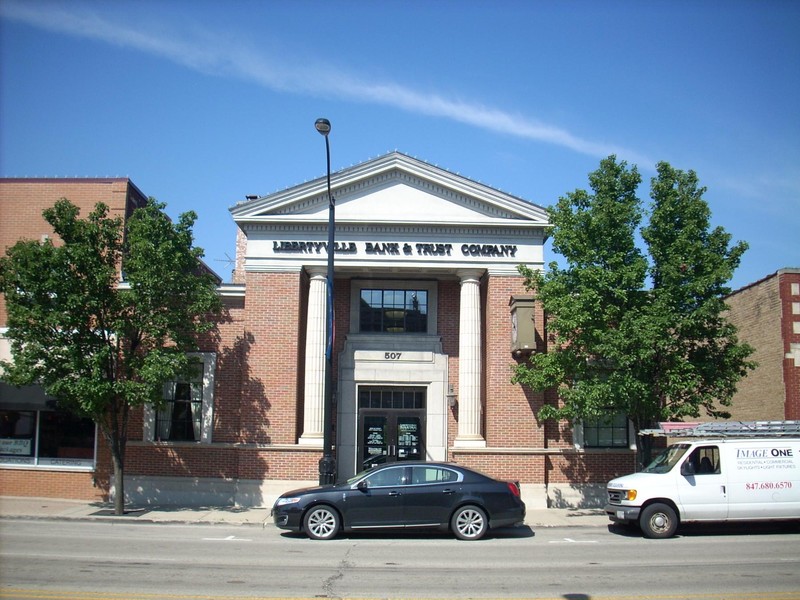
West side of Milwaukee looking north from Cook Avenue, about 1908. The bank building replaced the one-story building marked harness shop.
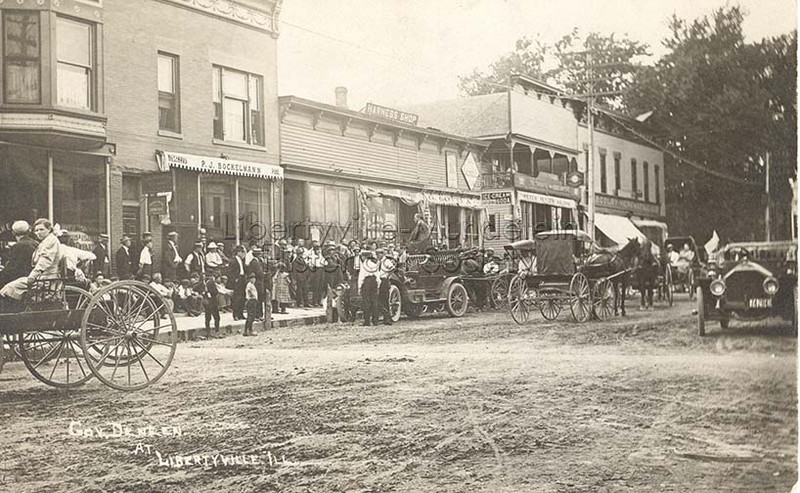
Lake County National Bank, 1923
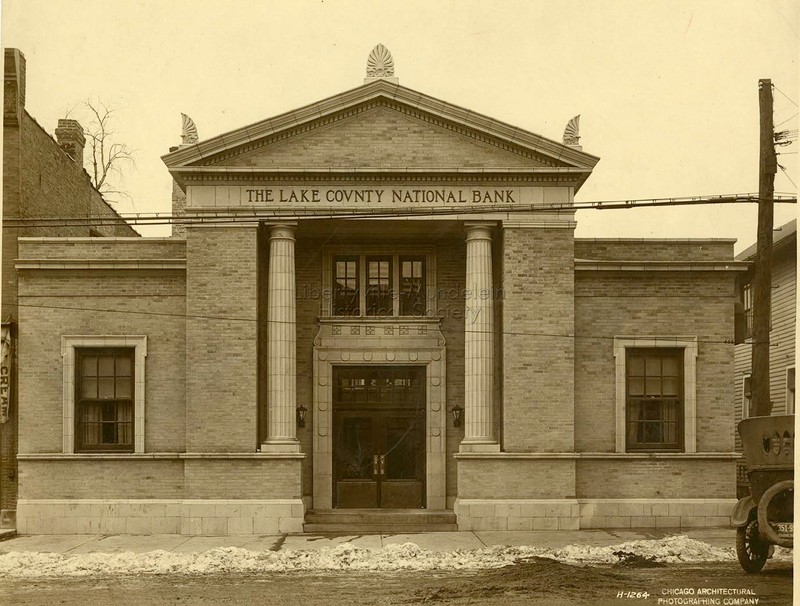
Lake County National Bank, interior, 1923

First Lake County National Bank, 1955
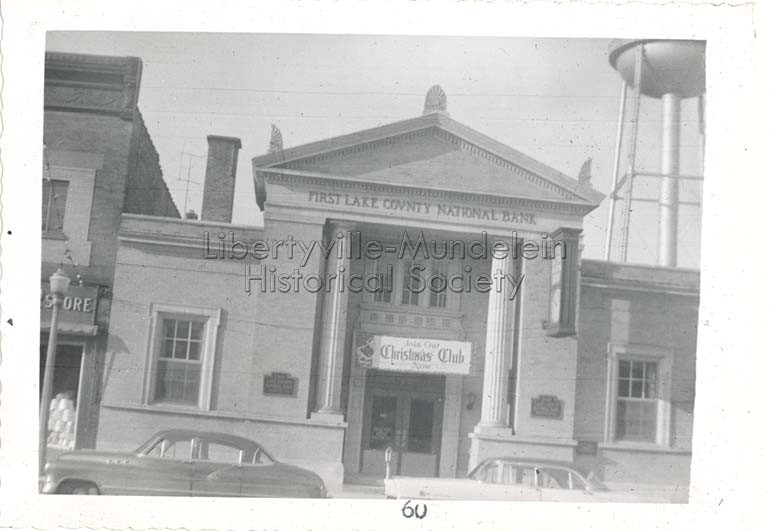
507 N. Milwaukee Avenue, circa 1975
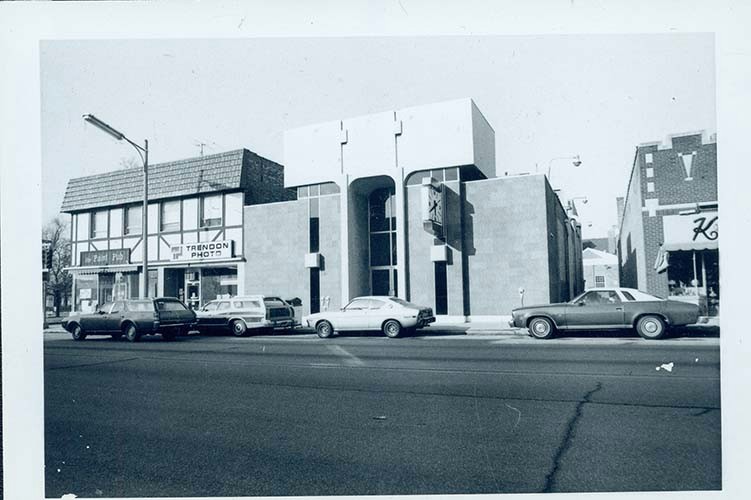
Heritage Galleria, 1994
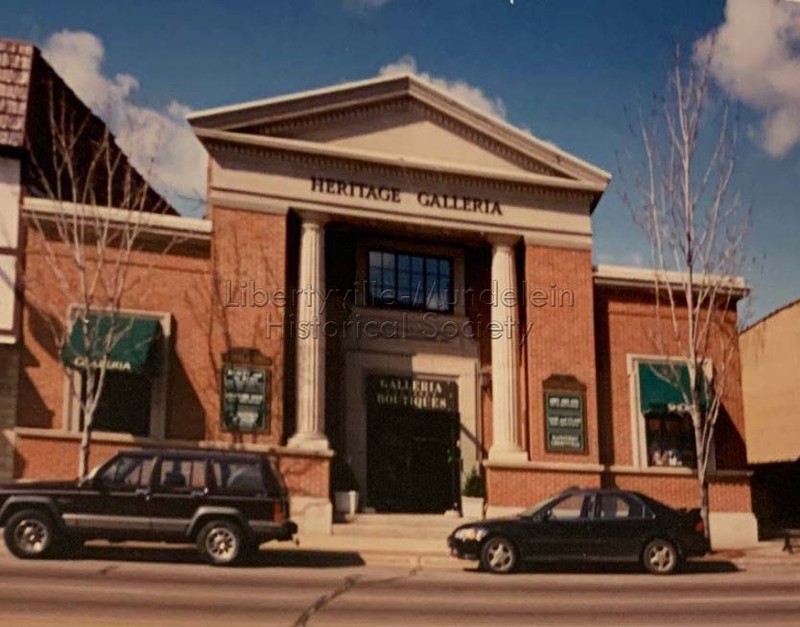
Backstory and Context
Text-to-speech Audio
Before the bank was built in 1923, three small wood-frame business buildings had stood on this site since at least the 1890s, housing (from south to north) for many years a tailor shop, Charles H. Kaiser's harness shop, and a third with more turnover. It was a meat market in 1897; a confectionery in 1907; and by 1912, housed Libertyville's first permanent movie theater, The Lyric Theater, operated by J. T. Robertson.
The Lake County National Bank purchased the property from C. H. Kaiser in 1920, and the frame buildings on the site, by then home to the Army and Navy Store and Flagg's barber shop, were demolished. The new building cost between $60,000 and $70,000, with a steel and concrete frame and brick exterior trimmed with terra cotta. Its classical revival style, featuring a full-height portico topped by a triangular pediment, fluted columns, and an entry surrounded by entablature, was popular at the time for banks, and had the added benefit of being "fire-proof." The interior was no less impressive, according to the Libertyville Independent: “Massive fire and burglar proof safe deposit vaults have been installed, all being protected by the latest electric alarm devices. The quarters for the bank’s business have been constructed not only with a view to efficiency, but also planned so as to reflect beauty and conveniently arranged for patrons. Aside from the rooms for the officers and customers, there are splendid waiting and rest rooms for gentlemen and ladies, tastefully furnished with all that goes to make the place inviting. Here folks from the country may meet their friends, rest from their shopping, and otherwise make use of the facilities offered by the bank.”
The bank flourished in its new home until the Great Depression struck, putting financial institutions everywhere, large and small, under tremendous strain. In 1933, Lake County National Bank and its former competitor, The First National Bank of Libertyville (housed across the street at 536-542 N. Milwaukee), combined their assets and merged as First Lake County National Bank, in this building. The facility underwent a significant renovation in 1949, with an interior remodel and a drive-up window added in the alley to the north. However, as automobiles grew larger and more numerous, and Milwaukee Avenue grew into a busier thoroughfare, this narrow alley became a traffic hazard. Improved drive-up and walk-up facilities, as well as a larger parking lot, were cited as reasons First Lake County National Bank chose to leave this site in 1968 and erect a new building around the corner at Cook and Brainerd. (Note: several name changes and acquisitions later, the institution still operates in this community, now as Chase Bank.)
In 1969, Modine Manufacturing Company, a thermal manufacturing concern based out of Racine, Wisconsin, opened business offices here. Modine was founded in 1916, building radiators for tractors and automobiles, and by the 1960s had grown to include ten manufacturing plants for all sorts of heat transfer devices. The company undertook a significant renovation of this building, rendering the facade largely unrecognizable with an aluminum finish front in the modernist style.
In the mid-1980s, Don and Shirley Mayworm, proprietors of Mayworm Associates healthcare publishers, acquired the building and restored many of its classical architectural elements. Mayworm Associates had offices on the second floor, and the first floor became the Heritage Galleria, which housed several arts-related shops and businesses, including Abbey Ames Attic gift shop, Millennium Art Gallery, and Sass and Class women's clothing and jewelry.
The building came full circle in 1995, when it was acquired by Wintrust to serve as a new location for one of a series of community banks it was forming in the Chicago suburbs, known as Libertyville Bank & Trust. The basement still housed the original vault. A 1999 renovation provided some updates to the facade but retained its classical character.
Sources
“New Building of the Lake County National Bank on Milwaukee Ave., “Libertyville Independent, March 1, 1923, p. 1
“Open House at National Bank Friday Night,” September 8, 1949, Independent Register p. 1
“Restoration Underway,” Independent Register, December 3, 1987
New Faces, Remodeling Brighten our Business Scene, Independent Register, March 27, 1969 p. 16.
“A Few Brief Items of Lake County News,” The Lake Forester, July 14, 1922, p. 6.
"New Lake County Bank Finds Home in Oldest Bank Building," Chicago Tribune, June 23, 1995. https://www.chicagotribune.com/news/ct-xpm-1995-06-23-9506230262-story.html
Sanborn Fire Insurance Map from Libertyville, Lake County, Illinois. Sanborn Map Company, Jul, 1897. Map. https://www.loc.gov/item/sanborn01973_001/.
Sanborn Fire Insurance Map from Libertyville, Lake County, Illinois. Sanborn Map Company, Aug, 1907. Map. https://www.loc.gov/item/sanborn01973_002/.
Sanborn Fire Insurance Map from Libertyville, Lake County, Illinois. Sanborn Map Company, Oct, 1912. Map. https://www.loc.gov/item/sanborn01973_003/.
Sanborn Fire Insurance Map from Libertyville, Lake County, Illinois. Sanborn Map Company, Oct, 1924. Map. https://www.loc.gov/item/sanborn01973_004/.
“Banking on Libertyville” Shelf Life Blog, Cook Memorial Public Library website, accessed August 27, 2020. https://shelflife.cooklib.org/2016/11/26/banking-on-libertyville/
Cook Memorial Library Clippings File, Businesses.
MilwaukeeAveN507, Historic Libertyville. Accessed August 27, 2020. http://www.historiclibertyville.com//index.php?c=3&project=yes&showonlyp=yes&p=756
Application for Historic District Designation, "Libertyville Downtown Historic District," Village of Libertyville, 2017. https://www.libertyville.com/DocumentCenter/View/18443/Historic-District-Application-100317?bidId=
Village of Libertyville. HistoricLibertyville.com.
Libertyville-Mundelein Historical Society. Postcards.
Libertyville-Mundelein Historical Society. Photo Book 3.
Libertyville-Mundelein Historical Society. Photo Book 3.
Libertyville-Mundelein Historical Society. Cizek Collection.
Libertyville-Mundelein Historical Society. Libertyville Township Assessor collection.
Libertyville-Mundelein Historical Society.
